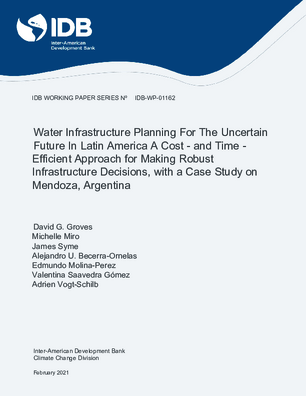Water Infrastructure Planning for the Uncertain Future in Latin America a Cost - and Time - Efficient Approach for Making Robust Infrastructure Decisions, with a Case Study on Mendoza, Argentina
Date
Feb 2021
Water administrators face growing challenges to meet water demand, which depends on socioeconomic and climatic conditions. The evolution of these conditions in the coming decades is deeply uncertain and unpredictable. This study demonstrates the utility of the Robust Decision Making (RDM) approach, a decision-making method under profound uncertainty, to assess water resource management's vulnerability and adaptation opportunities in Mendoza, Argentina.
The analysis confirms that Mendoza's current water system is vulnerable to changes in land use and the impacts of climate change. In nearly 900 futures analyzed, unmet demand grows significantly during drought periods, a problem that worsens over time. Most unmet need occurs in the agricultural sector, with shortages exceeding 35 percent in some years and futures. The vulnerability of the Tulumaya and Costa de Araujo basins was specifically analyzed, two downstream irrigation areas that exhibit high unmet demand in many futures and the agricultural sector as a whole. Three types of futures would lead to high unmet demand: 1. Rapid economic growth, except if rainfall increases significantly; 2. Trending urbanization under medium or dry climatic conditions; or 3. Accelerated urbanization under dry conditions and a pronounced temperature increase. Different strategies to reduce these vulnerabilities were evaluated: i) construction of a few large reservoirs, ii) smaller reservoirs, and iii) investments in pressurized irrigation. This is the first exercise comparing these three options under climatic uncertainties and land use. The results demonstrate that increasing storage through one or a few large reservoirs or a network of smaller reservoirs would not significantly mitigate these vulnerabilities and would be highly costly. Investments in pressurized irrigation could reduce vulnerabilities more significantly.
This analysis could be strengthened through additional iterations of the RDM approach, incorporating urban water demands more representatively, as well as a better reflection of the temporality of reservoir regulation and better representativeness of extreme climatic scenarios.
The analysis confirms that Mendoza's current water system is vulnerable to changes in land use and the impacts of climate change. In nearly 900 futures analyzed, unmet demand grows significantly during drought periods, a problem that worsens over time. Most unmet need occurs in the agricultural sector, with shortages exceeding 35 percent in some years and futures. The vulnerability of the Tulumaya and Costa de Araujo basins was specifically analyzed, two downstream irrigation areas that exhibit high unmet demand in many futures and the agricultural sector as a whole. Three types of futures would lead to high unmet demand: 1. Rapid economic growth, except if rainfall increases significantly; 2. Trending urbanization under medium or dry climatic conditions; or 3. Accelerated urbanization under dry conditions and a pronounced temperature increase. Different strategies to reduce these vulnerabilities were evaluated: i) construction of a few large reservoirs, ii) smaller reservoirs, and iii) investments in pressurized irrigation. This is the first exercise comparing these three options under climatic uncertainties and land use. The results demonstrate that increasing storage through one or a few large reservoirs or a network of smaller reservoirs would not significantly mitigate these vulnerabilities and would be highly costly. Investments in pressurized irrigation could reduce vulnerabilities more significantly.
This analysis could be strengthened through additional iterations of the RDM approach, incorporating urban water demands more representatively, as well as a better reflection of the temporality of reservoir regulation and better representativeness of extreme climatic scenarios.




